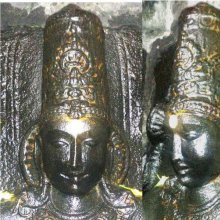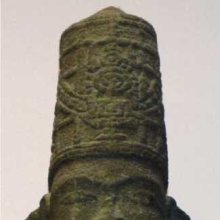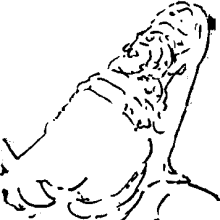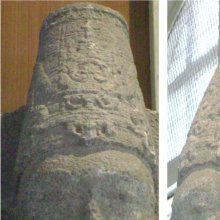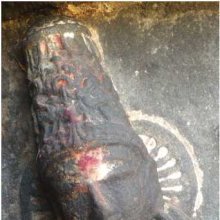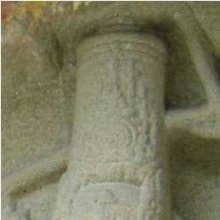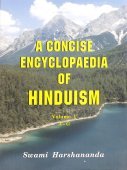Kirita, Kirīṭa: 23 definitions
Introduction:
Kirita means something in Hinduism, Sanskrit, Buddhism, Pali, Marathi, Jainism, Prakrit. If you want to know the exact meaning, history, etymology or English translation of this term then check out the descriptions on this page. Add your comment or reference to a book if you want to contribute to this summary article.
Images (photo gallery)
(+4 more images available)
In Hinduism
Purana and Itihasa (epic history)
Source: Google Books: Cultural History from the Vāyu PurānaKirīṭa (किरीट)—One of the Heavenly ornaments according to the Vāyu Purāṇa. Hari or Viṣṇu is called Kirīṭin.
Source: Cologne Digital Sanskrit Dictionaries: The Purana IndexKirīṭa (किरीट).—Of Viṣnu;1 of Kaṃsā.2
Source: JatLand: List of Mahabharata people and placesKirīṭa (किरीट) is a name mentioned in the Mahābhārata (cf. II.24.20) and represents one of the many proper names used for people and places. Note: The Mahābhārata (mentioning Kirīṭa) is a Sanskrit epic poem consisting of 100,000 ślokas (metrical verses) and is over 2000 years old.

The Purana (पुराण, purāṇas) refers to Sanskrit literature preserving ancient India’s vast cultural history, including historical legends, religious ceremonies, various arts and sciences. The eighteen mahapuranas total over 400,000 shlokas (metrical couplets) and date to at least several centuries BCE.
Chandas (prosody, study of Sanskrit metres)
Source: Shodhganga: a concise history of Sanskrit Chanda literatureKirīṭa (किरीट) refers to one of the 130 varṇavṛttas (syllabo-quantitative verse) dealt with in the second chapter of the Vṛttamuktāvalī, ascribed to Durgādatta (19th century), author of eight Sanskrit work and patronised by Hindupati: an ancient king of the Bundela tribe (presently Bundelkhand of Uttar Pradesh). A Varṇavṛtta (e.g., kirīṭa) refers to a type of classical Sanskrit metre depending on syllable count where the light-heavy patterns are fixed.
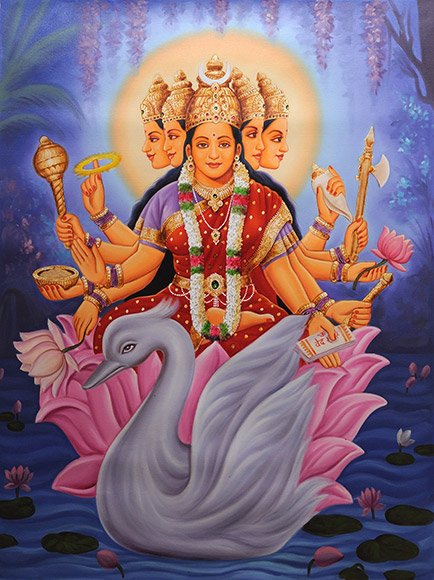
Chandas (छन्दस्) refers to Sanskrit prosody and represents one of the six Vedangas (auxiliary disciplines belonging to the study of the Vedas). The science of prosody (chandas-shastra) focusses on the study of the poetic meters such as the commonly known twenty-six metres mentioned by Pingalas.
Pancaratra (worship of Nārāyaṇa)
Source: archive.org: Isvara Samhita Vol 5Kirīṭa (किरीट) or Kirīṭamudrā is the name of a mudrā described in the Īśvarasaṃhitā 24.23-24.—Accordingly, “The two hands should be formed to resemble a bud and placed on the head uttering the (concerned) mantra. This is to be known as kirīṭamudrā, resembling ten thousand suns (in splendour)”. Mūdra (e.g., Kirīṭa-mudrā) is so called as it gives joy to the tattvas in the form of karman for those who offer spotless worship, drive out the defects which move about within and without and sealing up of what is done.
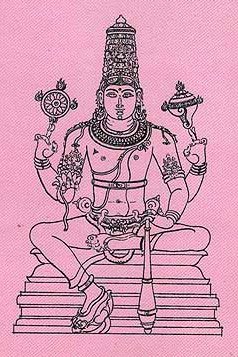
Pancaratra (पाञ्चरात्र, pāñcarātra) represents a tradition of Hinduism where Narayana is revered and worshipped. Closeley related to Vaishnavism, the Pancaratra literature includes various Agamas and tantras incorporating many Vaishnava philosophies.
Shilpashastra (iconography)
Source: Shodhganga: Vaisnava Agamas And Visnu ImagesKirīṭa (किरीट) refers to the “crown of a metal icon”, as defined in treatises such as the Pāñcarātra, Pādmasaṃhitā and Vaikhānasa-āgamas, extensively dealing with the technical features of temple art, iconography and architecture in Vaishnavism.—The Vaiṣṇava Āgamas insist that the metal icons should be made through a casting process called Madhūcchiṣṭa-kriyā. [...] After fine carving work the metal icon is fit on the pedestal which is known as jaṭibandhana. The metal icon is created and cast separately in two parts—a) the pīṭha and, b) the body of the icon from kirīṭa to the metal footplate (phalakā). The lower most part of the main icon (phalakā attached to the feet of the icon) is inserted into the socket (on top) of the pedestal after depositing the precious gems (ratna) into it.
In some icons, from kirīṭa to padmapīṭha is a single cast. In such, the padmapīṭha is placed and fit on the upapīṭha.
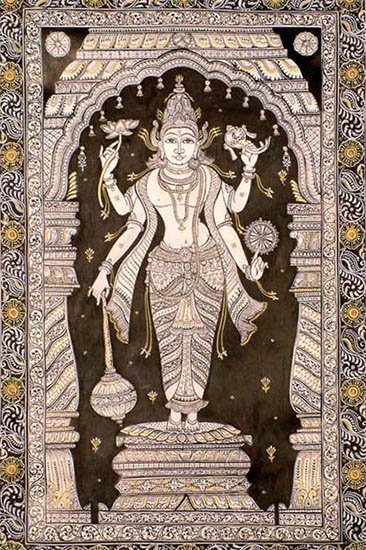
Shilpashastra (शिल्पशास्त्र, śilpaśāstra) represents the ancient Indian science (shastra) of creative arts (shilpa) such as sculpture, iconography and painting. Closely related to Vastushastra (architecture), they often share the same literature.
Shaktism (Shakta philosophy)
Source: Google Books: ManthanabhairavatantramKirīṭa (किरीट) refers to a “diadem”, according to the Śrīmatottara-tantra, an expansion of the Kubjikāmatatantra: the earliest popular and most authoritative Tantra of the Kubjikā cult.—Accordingly, while describing the Mūrti (visualized iconic form) of the goddess Mālinī: “She is like the rising sun and is blissful with wine. Very beautiful, she has five faces and is radiant with five time three eyes. She is adorned with beautiful earrings and shines with diadem and crown [i.e., kirīṭa-mukuṭa-ujjvalā]. She has ten arms adorned with many ornaments. O beloved, (she holds) a bow, javelin, conch, makes the gesture of fearlessness and holds a mirror. (Such) is the divine weapon in her left hands. (She holds) a thunderbolt, arrow, snake, makes a boon bestowing gesture and holds a rosary. O goddess, such is the divine weapon (held) by (her) right (hands)”.

Shakta (शाक्त, śākta) or Shaktism (śāktism) represents a tradition of Hinduism where the Goddess (Devi) is revered and worshipped. Shakta literature includes a range of scriptures, including various Agamas and Tantras, although its roots may be traced back to the Vedas.
Shaivism (Shaiva philosophy)
Source: Brill: Śaivism and the Tantric TraditionsKirīṭa (किरीट) refers to “diadems”, according to the 13th-century Matsyendrasaṃhitā: a Kubjikā-Tripurā oriented Tantric Yoga text of the Ṣaḍanvayaśāmbhava tradition from South India.—Accordingly, “[Visualisation of Parameśvara]:—[...] He is adorned with nice anklets, armlets, rings and bracelets, and he shines with small toe rings, channahīras, etc., and diadems (kirīṭa) and a crown. His face is gracious, beautiful, his lips are smeared with betel leaves. His mind is filled with the joy of wine, and his body is supreme bliss [itself]. [...]”.

Shaiva (शैव, śaiva) or Shaivism (śaivism) represents a tradition of Hinduism worshiping Shiva as the supreme being. Closely related to Shaktism, Shaiva literature includes a range of scriptures, including Tantras, while the root of this tradition may be traced back to the ancient Vedas.
General definition (in Hinduism)
Source: Wisdom Library: HinduismKirīṭa (किरीट, “crown”):—The crown is said to be the Unknowable Reality. (G.u.t.Up 59: kūṭasthaṃ sattvarūpaṃ ca kirīṭaṃ pravadanti mām |)
Languages of India and abroad
Pali-English dictionary
Source: BuddhaSasana: Concise Pali-English Dictionarykirīṭa : (nt.) a crown; diadem.

Pali is the language of the Tipiṭaka, which is the sacred canon of Theravāda Buddhism and contains much of the Buddha’s speech. Closeley related to Sanskrit, both languages are used interchangeably between religions.
Marathi-English dictionary
Source: DDSA: The Molesworth Marathi and English Dictionarykirīṭa (किरीट).—m n S A crest or diadem.
Source: DDSA: The Aryabhusan school dictionary, Marathi-Englishkirīṭa (किरीट).—m A crest or diadem.
Marathi is an Indo-European language having over 70 million native speakers people in (predominantly) Maharashtra India. Marathi, like many other Indo-Aryan languages, evolved from early forms of Prakrit, which itself is a subset of Sanskrit, one of the most ancient languages of the world.
Sanskrit dictionary
Source: DDSA: The practical Sanskrit-English dictionaryKirīṭa (किरीट).—[kṝ-kiṭan; Uṇādi-sūtra 4.184]
1) A diadem, crown, crest, tiara; किरीटबद्धाञ्जलयः (kirīṭabaddhāñjalayaḥ) Kumārasambhava 7.92.
2) A trader. See किराट (kirāṭa).
Derivable forms: kirīṭaḥ (किरीटः), kirīṭam (किरीटम्).
Source: Cologne Digital Sanskrit Dictionaries: Shabda-Sagara Sanskrit-English DictionaryKirīṭa (किरीट).—mn.
(-ṭaḥ-ṭaṃ) A crest, a diadem. E. kṝ to scatter, (pearls, &c.) and kīṭan Unadi aff.
Source: Cologne Digital Sanskrit Dictionaries: Benfey Sanskrit-English DictionaryKirīṭa (किरीट).—m. and n. A diadem. [Arjunasamāgama] 5, 13.
Source: Cologne Digital Sanskrit Dictionaries: Cappeller Sanskrit-English DictionaryKirīṭa (किरीट).—[neuter] diadem; [masculine] = kirāṭa.
Source: Cologne Digital Sanskrit Dictionaries: Monier-Williams Sanskrit-English Dictionary1) Kiriṭa (किरिट):—See ati-kir.
2) Kirīṭa (किरीट):—mfn. See ati-kir
3) n. [as m. [gana] ardharcādi], a diadem, crest, any ornament used as a crown, tiara, [Mahābhārata; Rāmāyaṇa] etc.
4) n. Name of a metre of four lines (each containing twenty-four syllables)
5) m. (= kirāṭa) a merchant, [Bhāgavata-purāṇa xii, 3, 35]
Source: Cologne Digital Sanskrit Dictionaries: Yates Sanskrit-English DictionaryKirīṭa (किरीट):—[(ṭaḥ-ṭaṃ)] 1. m. n. A crest, a diadem; a turban.
Source: DDSA: Paia-sadda-mahannavo; a comprehensive Prakrit Hindi dictionary (S)Kirīṭa (किरीट) in the Sanskrit language is related to the Prakrit words: Kirīḍa, Tirīḍa.
[Sanskrit to German]
Sanskrit, also spelled संस्कृतम् (saṃskṛtam), is an ancient language of India commonly seen as the grandmother of the Indo-European language family (even English!). Closely allied with Prakrit and Pali, Sanskrit is more exhaustive in both grammar and terms and has the most extensive collection of literature in the world, greatly surpassing its sister-languages Greek and Latin.
Prakrit-English dictionary
Source: DDSA: Paia-sadda-mahannavo; a comprehensive Prakrit Hindi dictionaryKirīta (किरीत) in the Prakrit language is related to the Sanskrit word: Krīta.
Prakrit is an ancient language closely associated with both Pali and Sanskrit. Jain literature is often composed in this language or sub-dialects, such as the Agamas and their commentaries which are written in Ardhamagadhi and Maharashtri Prakrit. The earliest extant texts can be dated to as early as the 4th century BCE although core portions might be older.
Kannada-English dictionary
Source: Alar: Kannada-English corpusKirīṭa (ಕಿರೀಟ):—
1) [noun] a circlet or headdress, often of gold and jewels, worn by a monarch as an emblem of sovereignty or by the winner of some contests as the beauty contest.
2) [noun] (fig.) a reward or honour.
3) [noun] a man who trades; a merchant; a trader.
4) [noun] ಕಿರೀಟ ಇಡು [kirita idu]/ಹೊರಿಸು [horisu] kirīṭa iḍu/horisu (fig.) (a distinctive accomplishment, achievement) to happen to make one feel proud of; to add a feather in one’s cap; 2. (sarc.) to reward or honour for one’s merits.
Kannada is a Dravidian language (as opposed to the Indo-European language family) mainly spoken in the southwestern region of India.
See also (Relevant definitions)
Starts with (+7): Kiritabhrit, Kiritacakkiri, Kiritadhamani, Kiritadharana, Kiritadharane, Kiritadharin, Kiritaggi, Kiritai, Kiritaka, Kiritam, Kiritamalin, Kiritamudra, Kiritamukuta, Kiritamukutojvala, Kiritan, Kiritana, Kiritanvita, Kiritapam, Kiritapamaram, Kiritapraya.
Ends with: Atikirita, Bhujakirita, Indukirita, Kikkirita, Kinkirita, Kirakirita, Krishnana-kirita, Tarakirita, Uttarakirita.
Full-text (+30): Kiriti, Kiritadharin, Kiritadharana, Atikirita, Tirida, Kiritamalin, Kiritataranam, Kiritabhrit, Kiritacakkiri, Kirida, Kiritatipati, Indukirita, Krishnana-kirita, Mukuta, Makuta, Hemakiritamalin, Kiritatari, Vimalakiritaharavat, Sakiritakaustubha, Avamuc.
Relevant text
Search found 27 books and stories containing Kirita, Kirīṭa, Kiriṭa, Kirīta; (plurals include: Kiritas, Kirīṭas, Kiriṭas, Kirītas). You can also click to the full overview containing English textual excerpts. Below are direct links for the most relevant articles:
Pallava period (Social and Cultural History) (by S. Krishnamurthy)
Crowns for Men (a): Kirita-makuta < [Chapter 4 - Material Culture of the People]
Head-dress of Men (Crowns) < [Chapter 4 - Material Culture of the People]
Head-dress of Women (d): Kirita-makuta < [Chapter 4 - Material Culture of the People]
Garga Samhita (English) (by Danavir Goswami)
Verse 8.13.4b < [Chapter 13 - A Thousand Names of Lord Balarāma]
Verse 2.9.29 < [Chapter 9 - Brahmā’s Prayers]
Verse 4.19.94 < [Chapter 19 - A Thousand Names of Srī Yamunā]
Cosmetics, Costumes and Ornaments in Ancient India (by Remadevi. O.)
2.1. Head Ornaments (a): Kirīṭa < [Chapter 3 - Ornaments]
2.1. Head Ornaments (b): Mukuṭa or Makuṭa < [Chapter 3 - Ornaments]
Head-Gears in Hindu Art < [March 1937]
A Fine Vijayanagar < [April – June, 1983]
Some Frescoes of the Cholas < [November-December 1933]
Bhakti-rasamrta-sindhu (by Śrīla Rūpa Gosvāmī)
Verse 2.1.359 < [Part 1 - Ecstatic Excitants (vibhāva)]
Verse 2.1.178 < [Part 1 - Ecstatic Excitants (vibhāva)]
Tiruvaymoli (Thiruvaimozhi): English translation (by S. Satyamurthi Ayyangar)
Pasuram 6.10.11 < [Section 10 - Tenth Tiruvaymoli (Ulakam unta Peruvaya)]
Related products
